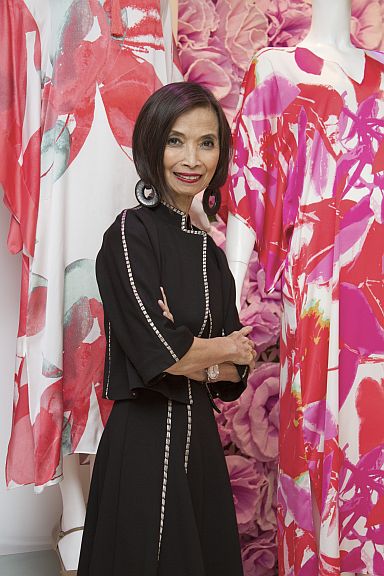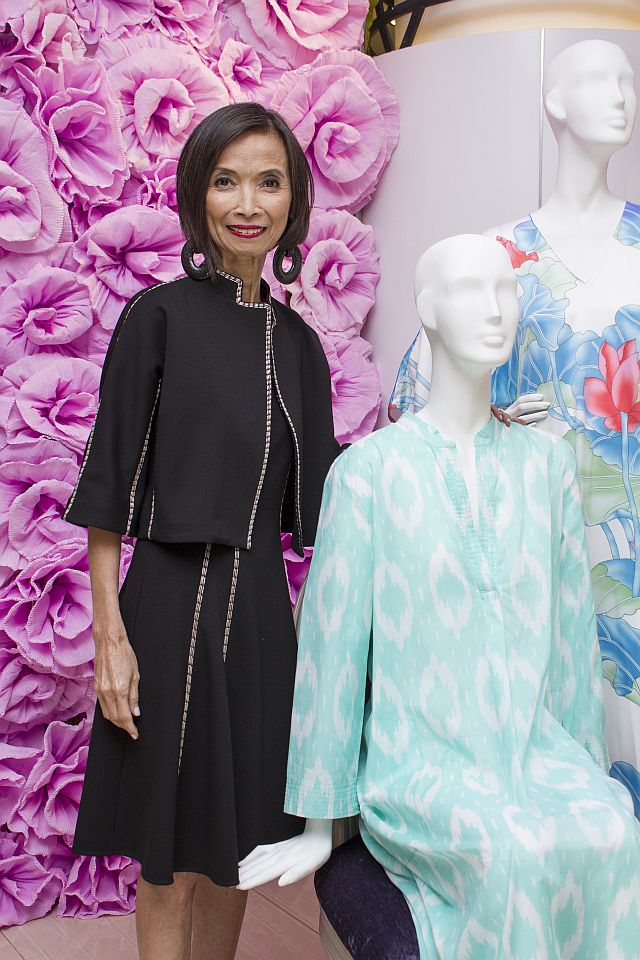
Josie Natori (CDN PHOTO/EDD BUENAVIAJE)
ELEGANT skirts and lingerie, kaftans and calligraphy printed tops, and bold brushstrokes with sharp colors make it to this season’s Spring Summer 2016 collection by the internationally-renowned fashion designer, Josie Natori.
Its a collection inspired by Asian Painting. But what truly makes a Natori piece stand out is the femininity and power that the wearer exudes.
In an evening dedicated to luxury fashion at Rustan’s Cebu and Gateway for Josie Natori’s namesake brand, the global style icon spared us a moment to talk about her philosophy on art as fashion and business.
The soft-spoken 68-year-old designer told us of her father, Engineer Felipe F. Cruz’s humble beginnings, and now there’s a street in Mandaue City named after him.
Josie also recalled receiving the prestigious Lakandula Award, which recognizes political and civic contributions for the Filipino people. From that fortunate incident with a buyer in Bloomingdale’s to the day Natori Company was born—Josie knew how to stand beautiful and successful. It takes hard work, good role models, and a good pair of well-tailored pants.
Tell us about your Spring Summer 2016 Collection.
This collection was inspired by Asian arts, so a lot of prints are brushstrokes, scribbles, Chinese calligraphy. The ease and sensibility is a Natori. It’s in the DNA of the brand, but you know, a collection evolves. Every season is not really of signature shapes or prints.
What’s a signature Natori creation?
Thirty-nine years is a long time and by now I think we have already defined the Natori signature. Our sense of color, the patterns, the east-west feeling, the details, the shapes, the embellishments… There’s an exoticness to it. So many different things you could say that it’s a Natori.
What do you want the wearer to feel when she slips into one of your creations?
Ultimately, when someone puts it on, I want her to feel good. My woman…she will feel glamorous and beautiful. That is definitely a Natori.
Would you consider yourself a trendsetter or a creator?
Kaftans are now a trend! (Laughs). The kimonos, too. But we stay true to what we are. I’d like to think we have our own sense of style. We’ve developed our sense of style and point of view through the years. It’s something that is right for the brand.
Did you always want to be a fashion designer?
God, no! (Laughs). I was in Wall Street for nine years, in investment banking. I’m also a pianist. Although I’ve been an artist since I was four years old, I have never dreamt, not in a million years, to be in this business. It’s just a lucky great accident that all this marries my creative sense and my business head…My left brain and my right brain! (Laughs)
How do you balance creativity and commerce?
That’s what I hoped we’d be able to create, and we’ve been able to create a brand. It’s marrying both the creative and the business. That’s why I still love what I’m doing 39 years later. In music, I believe that you never play the same note twice ever. It continues to evolve, expand to other products and brands, collections. It’s always changing. So without ideas you can’t really grow the business.

(CDN PHOTO/EDD BUENAVIAJE)
The story goes that it all started with a buyer at Bloomingdale’s.
Yes, she said, “Make it into a night shirt, this blouse”. And that’s how it started. I was in the right place at the right time. I ended up starting a business in the lingerie department, which I knew nothing about, but I approached it just like fashion. It has been a wonderful journey, and a tough one.
In the journey, what lesson stuck with you the most?
Be willing to make mistakes. It’s part of the process, so it’s not really a mistake because you learn from it. It’s learning and moving on. Also, you have to love what you’re doing. It’s very tough and unless you really love it, it’s not worth it. Stick to your vision and, your point of view, otherwise, you’re not going to stand out.
Other than passion, hard work, and a bit of luck, what else does it take to succeed?
You need good people around you. You have to be open and keep on evolving. You can’t be stuck. And you have to listen.
What is your philosophy in the art of fashion?
Number one, fashion is a business. It begins and ends there.
Tell us about your family.
I’m a hundred percent Filipino. (Laughs). My husband is Japanese-American. My mother is from Naga City, and my father is from Bulacan. Have you seen my mother? She’s out there.
Yes. Which of your mother’s attributes are like yours?
I obviously inherited from her, just the way she is. Just look at her at the age of 92. (Laughs). And my grandmother was also an inspiration to me. I’m the oldest of 32 grandchildren. Look at her! She’s always like that. Always looking good twenty-four seven; always being feminine. I was saying to somebody earlier that you can be strong, powerful, without losing your femininity.
The F.F. Cruz Street in Mandaue is your father’s—engineer Felipe F. Cruz.
Yes, that was his project. That was what he did. That’s his legacy. It’s quite amazing that he had this vision. It started in the 80s, I think, so the new Mandaue City is what he created.
How would you describe him?
My father is a self-made man. He’s the only one who graduated in his family. He’s a real entrepreneur. He’s an inspiration. He taught me to never put limitations on what you can be. I never had any reservations that I could be whatever I want to be. You have to make something out of yourself. It’s fortunate that I have a good role model and a good support from my family.
How would you see the Natori Company in the next five years?
Being a truly lifestyle brand that encompasses all aspects, we have from inside out, to fragrance to home, to accessories; I would just say my vision is having more lifestyle stores everywhere recognized globally.
What about the Natori men’s fashion?
My 40-year-old son is now the president of the company. I’m teasing him of his own sense of style. I see us surely heading to adding more lingerie for men. We had just launched our socks. The patterns are really fun, some dragons patterns. I would definitely see it starting in the lingerie area. Our first store is in New York in Elizabeth Street. That’s more like a laboratory for us.
Do you have a store here in the Philippines?
Yes, in Pasig. We produce in other countries but 80 percent is produced in the Philippines. Most of the expensive ones are produced in the Philippines.
What would you advise young aspiring fashion designers?
The opportunity today in this country has, more than ever, progressed. Filipinos have grown more appreciative of local designers. Be excited for the future! If you love it, go for it but understand that it is a business.

Featured designs in Josie Natori’s Spring 2016 collections. (CDN PHOTO/EDD BUENAVIAJE)
What is for you the simplest design that will take you all seasons?
Goodness gracious! Always have great pants! (Laughs). It’s seasonless! A great topper or a jacket would do too. Also, you have to have one great accessory to accentuate. And black. Black will never go out of style. When in doubt, wear black! (Laughs). I believe in timeless fashion.
How was it being a Lakandula awardee?
The president at the time was Gloria Arroyo. It was a gathering award from Ms. Aquino. Why is it always the women, right? (Laughs). We helped one another and we should! I believe in that. I was very grateful because it was the highest award that could be given to a Filipino. I have always been proud of my Filipino heritage. My heritage is the basis of what Natori is all about. It’s something I flaunt.
What was in your mind when you got the award?
That without my Filipino heritage, I wouldn’t be where I am now.
